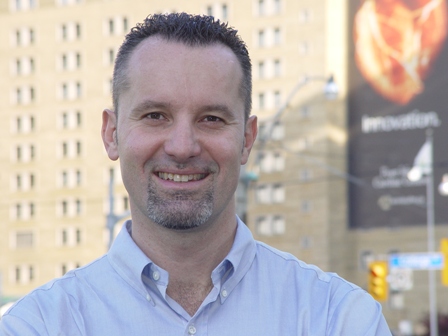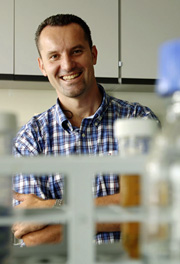
Sponsored Ads
|
» Home
» Science » Igor Stagljar distinguished Croatian molecular biologist in Toronto
» Home
» People » Igor Stagljar distinguished Croatian molecular biologist in Toronto
» Home
» Education » Igor Stagljar distinguished Croatian molecular biologist in Toronto
| Igor Stagljar distinguished Croatian molecular biologist in Toronto |
| By Marko Puljić |
Published
07/22/2009
|
Science , People , Education
|
Unrated
|
|
|
|
Igor Štagljar leading his team of young scientists in Toronto, part 1
 Igor Štagljar, professor at the University of Toronto. |
Dr. Igor Stagljar Igor Stagljar was born in Zagreb, Croatia, where he received his M.Sc. in Molecular Biology from the University of Zagreb in 1990. He then moved to Switzerland where he received his Ph.D. in Molecular Biology & Microbiology, from the Swiss Federal School of Technology (ETH) in Zurich in 1994. Afterwards he undertook two post-doctoral positions both at the University of Zurich, first working on RNA polymerase II transcription in mammals, and second on various aspects of DNA replication and repair in yeast. From 1999 to 2002, Igor was a Junior Group Leader and from 2002 to 2005 Assistant Professor at the University of Zurich. In 2001, he was a Visiting Scientist at the University of Washington, Seattle, USA, where he worked in the lab of Dr. Stanley Fields, the inventor of the yeast two-hybrid technology. Since the summer of 2005, Igor has been an Associate Professor at the Department of Biochemistry and the Department of Medical Genetics and Microbiology , University of Toronto. His labs are located in the Terrence Donnelly Center for Cellular and Biomolecular Research (CCBR), a new and cutting-edge, interdisciplinary research centre in the heart of Toronto's research district.

Igor coordinates zillions of projects in his group and enjoys interacting with his group members. He tries to create the opportunities for all of his group members to have cool, new projects. In his spare time, Igor is doing a lot of sport (swimming, jogging, and basketball), makes his own red wine, and plays acoustic guitar.

The captain of the boat, the fisherman of fishes: 
Source Igor Štagljar Laboratory
|
Uspjeh u znanosti uspjeh je tima
Kao molekularni biolog prije deset godina Igor Štagljar počeo je - na glasovitome Švicarskome nacionalnom tehnološkom institutu ETH-u, gdje je doktorirao i poslije bio jedan od najmlađih profesora - razvijati sa svojim znanstvenim timom originalnu biotehnološku metodu za identifikaciju novih proteina uključenih u nastanak raka. Ta mu je metoda otvorila putove u proučavanju teških genetskih bolesti, osobito cistične fibroze, a za njezino je liječenje, zahvaljujući upravo prof. Štagljaru, potreban, kako se vjeruje, još samo jedan korak.
P. = pitanje, O. = odgovor
P. Razvili ste sa suradnicima, i patentirali, tehnologiju membranskoga dualnog sustava (MYTH). Najjednostavnije objašnjeno, o kakvoj je tehnologiji riječ i zašto je ona tako epohalna, kako je ocijenjena u svjetskim znanstvenim krugovima? Primjerice, utjecajni znanstveni časopis The Scientist uvrstio ju je među sedam tehnologija u području istraživanja života, koje će u idućem desetljeću obilježiti biomedicinske znanosti. Zbog nje ste, na posljetku, nagrađeni najuglednijim kanadskim priznanjem za inovaciju... Što Vaša tehnologija znači za samo istraživanje i, možda, jednoga dana za liječenje genetskih bolesti?
O. Tehnologija MYTH jest molekularno-biološka
metoda kojom se mogu pratiti kontakti među proteinima ili tzv. proteinske interakcije. Što to,
jednostavno rečeno, znači? Proteini su važne makromolekule u svim organizmima, gdje obavljaju mnogo esencijalnih funkcija. Prilikom obavljanja tih funkcija proteini nikad ne djeluju sami, nego kontaktiraju druge proteine. Mnoge ljudske bolesti posljedica su ili prekida normalnih ili nastanka novih proteinskih interakcija. Zato je vrlo važno biti kadar pratiti i detektirati proteinske interakcije preko molekularnobioloških metoda, jer tako možemo spoznati kako razviti nove terapije protiv brojnih ljudskih bolesti. Sve te navedene proteinske interakcije možemo pratiti MYTH tehnologijom, a njezina najveća prednost pred ostalim tehnologijama kojima se danas koristi u molekularnoj biologiji jest činjenica da je to zasad jedina metoda koja se uspješno može primijeniti na velikom broju proteina što se nalaze na samoj periferiji stanice. Primjerice, ljudski proteini koji su uključeni u nastanak cistične fibroze, Alzheimerove bolesti, shizo-frenije, Parkinsonove bolesti, tumora mozga, pluća i dojke, kao i brojnih drugih bolesti mogu se izravno analizirati našom MYTH metodom. Na taj je način, MYTH tehnologija prvi korak u procesu razvitka novih lijekova
(eng. drug discovery) jer s pomoću nje možemo otkriti nove ciljne molekule (tzv. drug targets),
koje ćemo poslije pokušati ili uništiti ili popraviti dotičnim lijekom.
P. Vaše je znanstveno područje proteomika. Kakva je to zapravo medicinska disciplina?
O. Proteomika (engl. Proteomics) jest vrlo mlada subdisciplina molekularne biologije (rođena u
početku ovog stoljeća) čiji je zadatak dekodirati funkciju svih proteina u ljudskom organizmu.
Proteom je stručni naziv za skup svih proteina u određenom organizmu. Primjerice, iako sve ljudske stanice sadržavaju otprilike 26.000 gena, ljudski proteom ima otprilike deset puta više proteina, dakle otprilike oko 260.000. Od tih 260.000 proteina samo je njih petsotinjak, po našim sadašnjim spoznajama, izravno uključeno u nastanak ljudskih bolesti. Zanimljivo je spomenuti kako znanstvenici pretpostavljaju da sveukupno postoji oko 3000 proteina u našem organizmu, koji su uključeni u nastanak različitih bolesti, što znači da još moramo pronaći preostalih 2.500 proteina (tzv. drug targeta) i njihovu egzaktnu vezu s navedenim bolestima...
P. Možete li objasniti Vaša nedavna znanstvena otkrića vezana uz cističnu fibrozu, neizlječivu i najčešće nasljednu bolest? Koja je tajna te bolesti i kad bi Vaše otkriće moglo rezultirati lijekom za tu bolest?
O. Cisticna fibroza (CF) opaka je nasljedna bolest uzrokovana promjenama u ljudskom CFTR genu, a u prosjeku pogađa jedno od 2500 novorođene djece. Kod oboljelih začepljeni su dišni putovi i gušterača, a bolest također pogađa i znojne žlijezde, kao i reproduktivni sustav. MYTH tehnologija idealna je za proučavanje proteina kao što je CFTR, jer CFTR nalazi se na periferiji (membrani) ljudskih stanica, gdje pomaže transportu kloridnih iona u unutrašnjost i izvan stanice. Upravo zbog te izravne veze CFTR-a s cističnom fibrozom, odlučili smo da MYTH tehnologiju najprije testiramo na CFTR proteinu i nedavno prvi put identificirali šest novih proteina koji komuniciraju sa CFTR-om. No, ono što je najvažnije jest otkriće da jedan od tih šest navedenih proteina, pod imenom TUS1, znatno pomaže CFTR-u prilikom obavljanja njegove funkcije. Drugim riječima, na molekularnoj razini otkrili smo potpuno novi način na koji funkcionira CFTR, i to se otkriće pokazalo važnim za razvoj
novih terapija protiv cistične fibroze.
P. Hoće li to Vaše novo otkriće uskoro rezultirati proizvodnjom lijeka za cističnu fibrozu?
O. Što se tiče našeg otkrića i razvitka novog lijeka protiv CF-a, put je još dug te će nam za to još trebati razdoblje od otprilike 7-8 godina. No htio bih spomenuti da je američka tvrtka Vertex Pharmaceuticals iz Bostona nedavno razvila novi lijek pod imenom VX-770, koji bi vrlo uskoro mogao znatno popraviti kvalitetu života pacijenata oboljelih od CF-a. Spomenuti lijek radi na principu da korigira funkciju promijenjenog CFTR proteina te se na američkom tržištu očekuje do kraja godine.
P. Za proizvodnju jednog novoga lijeka potrebno je prosječno oko 800,000.000 američkih dolara. Je li to glavni razlog zašto se tako dugo, pošto znanstvenici daju smjernice, čeka lijek?
O. Glavni razlog zbog čega je proces pronalaska lijekova tako skup jest to da od bazičnih laboratorijskih otkrića, dakle otkrića tzv. ciljne molekule koju treba uništiti ili popraviti s lijekom, do upotrebe lijekova u klinici, protekne u prosjeku 10 do 15 godina. Vidite i sami da je riječ o dugotrajnom procesu u kojemu dotični lijek mora proći kroz četiri različite faze istraživanja koje su, kao što se može zapaziti iz navedene novčane svote, veoma skupe. Možda će zvučati zapanjujuće, ali tek svaki peti lijek koji se pojavi na tržištu financijski vrati ulaganje od njegove prodaje, što znači da je cjelokupni proces otkrivanja lijekova još i danas prilično neučinkovit. Upravo zato suvremena medicina i molekularna biologija ulažu golema sredstva u razvitak novih tehnologija koje će navedene neuspjehe svesti na minimum. I upravo su zato u procesu otkrivanja lijekova uključeni stručnjaci iz različitih disciplina kao što su liječnici, molekularni biolozi, kemičari, ali i informatički specijalisti.
P. Bavite se molekularno-biološkim istraživanjem genetskih bolesti, što je danas top znanost od koje se očekuje, među ostalim, spasonosno rješenje za borbu protiv karcinoma. Sada diljem svijeta mnogo znanstvenih timova razvija nove terapije i postoji nada da će netko od njih, danassutra dati revolucionarno otkriće, tj. lijek. Ali, Vi niste tako optimistični.
O. Da, imate pravo kad kažete da je to jedan od najvažnijih zadataka današnje molekularne biologije i medicine. No kao znanstvenik koji se bavi tim istraživanjima želim, prije svega, odaslati iskrenu poruku javnosti da mi nikad nećemo biti kadri stvoriti jedan jedini univerzalni lijek protiv svih karcinoma. Zašto? Zato što na temelju današnjih opširnih molekularnih, imunoloških, histopatoloških i drugih spoznaja o tumorima možemo govoriti o
postojanju dvjestotinjak različitih tumora u ljudskom organizmu. Gotovo svaki od tih tumora jedinstven je jer uzrokuju ga molekularne promjene u različitim genima i njihovim proteinskim produktima. Glavni cilj suvremene molekularne biologije prije svega je razumjeti svaki od tih dvjesto tumora kao jedinku za sebe, tj. shvatiti koje promjene u genima i njihovim proteinskim produktima dovode do pojave tih tumora - to je jedini način na koji ćemo moći kreirati nove, pametne lijekove što će biti efikasni u suzbijanju tumora. Htio bih još spomenuti da su molekularna biologija i medicina u posljednjih deset godina postigli zapaženi napredak u stvaranju nekoliko takvih pametnih lijekova kao sto su to npr. Herceptin, monoklonalno protutijelo što se primjenjuje u liječenju metastaza dojke, zatim Gleevec, kojim se koristi u liječenju mijeloične leukemije, te Sutent, koji se primjenjuje u liječenju tumora bubrega i gastrointesticijskih tumora želuca. Uza spomenute lijekove, u kliničkim pokusima u visokorazvijenim zemljama, danas se testira pedestak novih pametnih lijekova protiv različitih vrsta tumora.
P. Lani ste otkrili kemijske supstancije koje blokiraju djelovanje opasne bakterije Pseudomonas aeruginosa? Možete li objasniti to otkriće, prevesti ga s jezika znanosti na govorni jezik?
O. Naša posljednja istraživanja probudila su nadu u razvoj novih terapija u liječenju pseudomonalnih infekcija koje su, među ostalim, glavni uzročnik smrti oboljelih od cistične fibroze, osoba oslabljena imuniteta kao i osoba oboljelih od side. Jednostavno rečeno, razvili smo novi znanstveni pristup s pomoću kojega se mogu pronalaziti lijekovi koji neutra-liziraju infekcije izazvane patogenom bakterijom Pseudomonas aeruginosa. Taj je naš pristup osobit u tome Tako smo pronašli novi lijek (nazvali smo ga Exosin) koji uvelike reducira infekcije prouzročene dotičnom bakterijom. Osim toga, razjasnili smo mehanizam na samoj razini molekula u ljudskim stanicama preko kojega djeluje Exosin i tako postavili temelje za novi lijek protiv pseudomonalnih infekcija.
|
Successes in Science are Successes of a Whole Team
Ten years ago, Igor Štagljar as a molecular biologist at the famous Swiss Federal Institute of Tehnology ETH - where he received his Ph.D. and went on to become one of the youngest professors - he and his team of scientists began developing an original biological method for the identification of new proteins involved in the development of cancer. This method paved the way for the research of grave genetic diseases, particularly cystic fibrosis. Thanks to professor Štagljar, it is now believed that we are only a step away from finding a cure for this disease.
Q. = question, A. = answer
Q. With your associates you have developed and patented the membrane dual system technology (MYTH). Could you briefly explain the theory and the technology and tell us why the international scientific community hailed it as a groundbreaking development? The major scientific magazine The Scientist, for example, added it to the seven life research technologies that would dominate biomedical science in the next decade. This technology has also earned you the most prestigious Canadian innovation grant... What does your technology mean for research itself and, perhaps one day, for the treatment of genetic diseases?
A. MYTH technology is a molecular biological method which enables us to monitor contact
between proteins or the so-called protein interactions. Now, what does this mean in simple terms? Proteins are important macromolecules in all organisms, in which they perform many essential functions. In the performance of these functions, proteins never act on their own, but rather contact other proteins. Many human diseases develop as the consequence either of an interruption of normal protein interactions or of the occurrence of new ones. This is why it is very important to be able to monitor and detect protein interactions through molecular biological methods, because it can help us understand how to develop new therapies for various human diseases. We can monitor all of these protein interactions with MYTH technology, and its greatest advantage, in comparison to other technologies used in molecular biology today, lies in the fact that this is currently the only method that can be successfully applied to a great number of proteins situated on the very perimeter of the cell. For example, human proteins involved in the development of cystic fibrosis, Alzheimer's disease, schizophrenia, Parkinson's disease, tumours of the brain, lungs, breasts, and many other diseases can be directly analyzed using our MYTH method. In this way, MYTH technology is the first step in the drug discovery process because it can help us discover new target molecules (drug targets) which we will then try to destroy or improve with the drug.
Q. Your area of science is called proteomics. What is this medical discipline like?
A. Proteomics is a very young sub-discipline of molecular biology (born at the very beginning of this century) with the task of decoding the function of all proteins in the human organism. Proteome is the term used to describe a set of all proteins in an organism. For example, even though all human cells contain approximately 26,000 genes, the human proteome consists of approximately ten times more proteins, around 260,000. Of the 260,000 proteins only some five hundred, according to our current findings, are directly involved in the development of human diseases. I should mention that scientists assume that there are some 3000 proteins in our organism involved in the development of different diseases, which means that we still have to find the remaining 2500 proteins (drug targets) and their exact connection with the corresponding diseases...
Q. Can you tell us more about your recent scientific discoveries on cystic fibrosis, an incurable and most commonly hereditary disease? What is the secret to this disease and when could we expect your discovery to result in the cure for the disease?
A. Cystic fibrosis is a vicious hereditary disease caused by modifications to the human CFTR gene, and is found in approximately one in 2500 newborn children. Patients experience clogging of the airways and of the pancreas and the disease also affects the sweat glands and the reproductive system. MYTH technology is ideal for conducting research on proteins such as CFTR, because CFTR is located on the periphery (membrane) of human cells, where it helps to transport chloride ions in and out of the cell. It is precisely because of this direct connection of CFTR with cystic fibrosis that we have decided to test MYTH technology on CFTR protein first and recently we were able to identify for the first time six new proteins that communicate with CFTR. But the most important part of our discovery was that one of the six proteins, TUS1, has an important role in helping CFTR renew its function. In other words, we have discovered an entirely new way that CFTR functions at the molecular level and this discovery has proved to be significant for the development of new therapies for the treatment of cystic fibrosis.
Q. Is your new discovery going to result in the cure for cystic fibrosis any time soon?
A. When it comes to our discovery and the development of a new drug for CF, we still have a long way to go; it will take some 7-8 years. But I would like to say that the Boston-based American company Vertex Pharmaceuticals recently developed a new drug called VX-770 which could significantly improve the quality of life of CF patients very soon. This drug functions by correcting the function of the modified CFTR protein and is expected to be available in the US market by the end of this year.
Q. The production of a new drug costs approximately 800,000,000 US dollars. Is this the main reason why so much time has to pass between the initial scientific discovery and the production of a drug?
A. The main reason for the high cost of drug development is the fact that it takes an average of 10 to 15 years from the time of basic laboratory discoveries, to the discovery of the target molecule to be destroyed or improved with the drug, to the clinical use of drugs. As you can see, this is a lengthy process in which the drug in question has to pass through four different research phases which, as you can see by the amounts cited, are very expensive. This may surprise you, but only every fifth drug on the market can assure a return of the funds invested in its development, meaning that the entire drug development process is still quite inefficient. This is why modern medicine and molecular biology are now investing great amounts of money in the development of new technologies which would reduce the failure rate to a minimum. And this is also why drug development processes involve experts from different fields such as doctors, molecular biologists, chemists, but also IT specialists.
Q. You work on molecular biological research of genetic diseases, which is the leading branch of science today, and it is expected to yield, among other things, a solution for the fight against cancer. Numerous scientific teams around the world are developing new therapies as we speak and there is hope that one of them will produce a revolutionary solution any day now, a cure. But you are not that optimistic.
A. Yes, you are right when you say this is one of the most important tasks of molecular biology and medicine today. But as a scientist involved in this type of research, I would like to be frank and tell the general public that we will never be able to create a single universal cure for all types of cancer. Why is this so? Because, based on elaborate molecular, immunological, histopathological and other data on tumours that we have today, we can identify around two hundred different types of tumours in the human organism. Almost each of these tumours is unique because it is caused by molecular modifications in different genes and their protein products. The main goal of modern molecular biology is primarily to understand each of the two hundred tumours as an individual unit, that is, to understand the changes in the genes and their protein products that result in these tumours - this is the only way in which we will be able to create new, smart drugs, efficient in fighting tumours. I would also like to say that in the last ten years molecular biology and medicine have made significant progress in creating several smart drugs, such as Herceptin, a monoclonal antibody applied in the treatment of breast cancer metastasis, then Gleevec, used in the treatment of myeloid leukaemia, and Sutent, used in the treatment of kidney tumours and gastrointestinal stomach tumours. Along with these drugs, some fifty new smart drugs against different types of tumours are being clinically tested in leading developed countries.
Q. Last year you discovered chemical substances that block the activity of the dangerous bacteria Pseudomonas aeruginosa. Can you tell us more about this discovery and translate it for us from the scientific to everyday language?
A. Our latest research has kindled hope in the development of new therapy for the treatment of pseudomonas infections which are one of the main causes of death in cystic fibrosis patients, persons with weakened immunity and AIDS patients. Basically, we have developed a new scientific approach to the development of drugs that neutralize infections caused by the pathogenic bacteria Pseudomonas aeruginosa. Our approach is unique in that the entire drug screening process takes place in brewer's yeast. This is how we found a new drug (we called it Exosin) which greatly reduces infections caused by the said bacteria. Also, we shed light on the mechanism at the molecular level in human cells through which Exosin acts and thus we set the foundations for a new drug for pseudomonas infections.
| Please, go to the next page below.
|
|
|
|
|